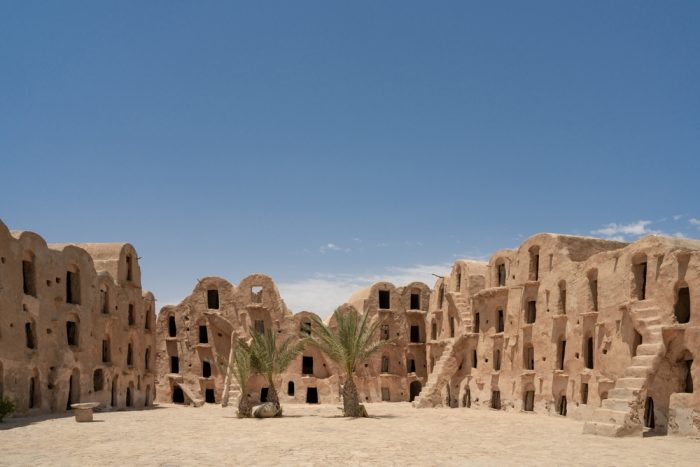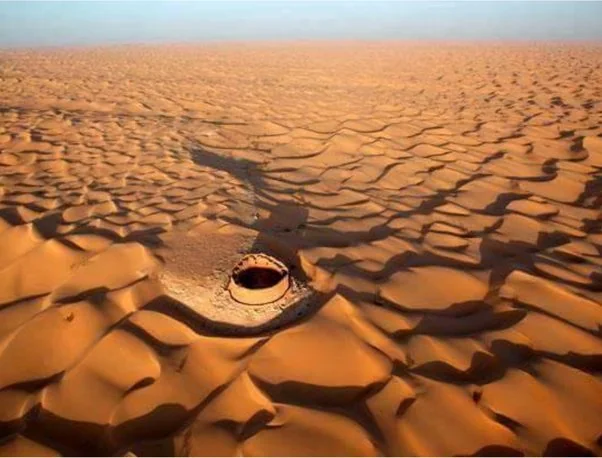Recently, a spectacular image of a castle-like structure standing in the middle of a dune sea has been circulating on the internet. Deep in the Algerian interior, this ancient building called Ksar Draa puzzles with its lack of information. No one knows who built it, or why, or when.
A lost past
To find any scrap of information on this place, you have to jump through a few hoops. You will come across a couple of Facebook and Reddit posts, an obscure blog here and there, and not-so-helpful travel websites with shoddy translations from Arabic and French. For a land so ancient and rich in history, Algeria sure has its mysteries.
The sources that do cover the topic list these details: Ksar Draa lies near the town of Timimoun in Adrar Province. It has a circular double wall two meters high, with three levels, multiple rooms, no windows, no staircases, and a courtyard below. It also rises above the rolling sand dunes.
Leading guesses about its function vary: a caravanserai (a kind of inn for caravans journeying through the desert), a fortified castle, a prison, a granary, or a trading post. Most sources suggest that it could be of Jewish origin because of the presence of a lone Jewish symbol on one wall. And that is pretty much it.

Tunisian ksar
What a ksar traditionally looks like. This is in Southern Tunisia and was also featured in Star Wars. Photo: skarzarphoto/Shutterstock
Locals also don’t know how this structure came to be. Supposedly, an American team visited it in the 1980s to solve this puzzle, but this writer hasn’t found any of their reports. Another dead end. What is it about this castle-fort-thing that continues to elude us?
What is a ksar?
First of all, what does the word “ksar” mean? A ksar (plural form: ksour) is a regional term for “fortified village.” Other connotations of the word suggest “palace” or “castle.” You can find ksour all over Algeria, Morocco, Tunisia, and other North African countries.
Ksour look like a group of separate houses joined together, built with mainly adobe stone, clay, and earth plaster. Multi-purpose in nature, they hold living quarters, store rooms, and even mosques. Its high, long walls were designed to defend the occupants inside.
The region and its history
Ksar Draa lies in central Algeria, specifically, in the wider Touat desert. This region held a network of important oases for travelers venturing further into the harsh Sahara. Ksour were purposely built around these oases.

According to Arabic and European medieval sources, Jews have lived in the Touat since the 1st century AD. Initially, they were fleeing persecution by the Roman emperor Trajan. Most came from Cyrenaica, around today’s eastern Libya.
Despite their traumatic beginnings, the Jews of Touat grew quite influential and were “under the protection of several rulers” and “enjoyed very secure social standing,” according to Genoese trader Antonio Malfante, who reported on the trans-Saharan trade in the 1440s.
Records show that economic success made this Jewish community almost a miniature kingdom within the region. They specialized in Saharan gold and jewels. The capital, Tamentit, grew into a great trading and cultural hub. You could find hundreds of jewelers, smiths, learned men, religious schools, and synagogues. The Jews also seemed to get along with Muslims in the area for a time, despite occasional hostile incidents.
Then in 1492, an angry fanatic from Morocco named al-Maghili encouraged anti-Jewish sentiment among the Muslims. They rose up against their Jewish neighbors, causing a bloodbath and the destruction of the town. Those who survived scattered and fled for their lives.
Theories
With this historical background, we can start to see a picture of the region develop. The architecture of Ksar Draa does have elements of defense to it. The double wall indicates extra security and can make it harder for outside forces to enter the premises. Its circular design allows surveillance of the dunes from all angles. The building happens to sit atop a dune at a height that makes seeing enemies from afar much easier.

The lack of staircases to get to the small openings of the rooms could have kept enemies out. Removable ladders were likely used to go up and down. Also, no windows either meant that the occupants did not want to be seen or made it easier to secure entrance to the dwellings.
It appears that the complex had security in mind. So, the expelled Jews from Cyrenaica could have built it to keep themselves safe, and it could have housed the Jews fleeing the Tamentit bloodbath in 1492.
If it was a stop for caravans traveling further into the Sahara, travelers would have had rooms to stay in and a place to replenish their supplies before their long journey onward. However, not having something as simple as a staircase would have made the stay a bit inconvenient.
Or perhaps, it was a fort and a trading post combined. The building could both provide lodgings for travelers and protect the Jews living there.

Conclusion
It is astounding that there remains no certain explanation for Ksar Draa’s existence. The Jews, of course, endured further persecution over the centuries, which culminated after World War II in a mass exodus to Israel. This may have played a part in the loss of information. Oral traditions or generational stories may have died with the persecuted.
While there has not been any recent archaeological activity in Ksar Draa, we can safely say that whoever built it wanted to keep someone or something out.

